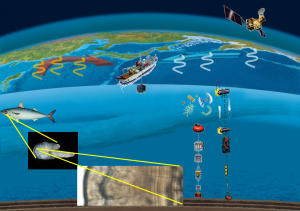Overview
Purpose of the Research Project
Ocean diapycnal mixing is a fundamental physical process that regulates ocean vertical circulations of water, nutrients, carbon and heat; however, its distribution and generation mechanisms have not been known because of the difficulties of observations. This research project will develop efficient observing system of ocean diapycnal mixing and next-generation numerical models, those of which are able to quantify the maintenance mechanism of deep and bio-geochemical circulations and to reproduce observed bi-decadal ocean and climate variability. This new interdisciplinary study on ocean mixing opens the integrated sciences from physical, chemical, biological oceanography to climate and fisheries sciences.
Content of the Research Project
Based on extensive and/or intensive in-situ observations, turbulent vertical mixing and physical, chemical and biological oceanic processes in the western North Pacific, especially in the Oyashio and Kuroshio regions and their upstream regions including East-Asian marginal Seas, will quantify the transport of water and nutrients. Implementation of the observed data and new findings on physical and biogeochemical processes into a data-synthesis system and prognostic models makes possible to further quantify those without observations. With diapycnal diffusivity and its 18.6-year variability, high-resolution newly developing next-generation models with atmosphere and biogeochemical components will enable us to pursue the effects of local vertical mixing such as Kuril Straits mixing on global ocean and climate and their bi-decadal and its related variabilities.
Changes in biomass and species of major phytoplankton will be analyzed by19-years time series settling particle samples. Biogeochemical responses to the environmental change will also be monitored by sensors equipped with up-down winch system (see figure). Stable isotope analysis technics of fish otoliths will be developed to elucidate influences of ocean mixing variability on fluctuations of the fish stocks (see figure).

Schematic representation of bio-geochemical observations and our hypothesis: strong tide-induced diapycnal mixing in the upstream Oyashio and Kuroshio supplies nutrients and maintains abundant ecosystem including fish species.
Expected Research Achievements and Scientific Significance
Integrated observations of diapycnal diffusivity and physical, bio-geochemical and fish-recruitment processes in the western North Pacific are implemented to next generation (data-assimilation and prognostic) models which reproduce ocean biogeochemical circulation and observed long-term ocean and climate variability. Those observations and models elucidate our hypotheses that diapycnal upwelling of nutrients in the upstream Oyashio and Kuroshio makes the ocean around Japan productive and that 18.6-year period tidal mixing leads to ocean, climate and marine ecosystem bi-decadal variability, which enhance long-term predictive skills of climate and marine ecosystems including fish stocks.
Key Words
Ocean diapycnal mixing: vertical mixing of seawater and dissolved substances due to turbulent eddies. In deep water, these eddies are caused by breaking internal waves generated by currents as tides over rough bottom topography, inducing ocean vertical water, heat and material circulations.
Term of Project
FY2015-2019
Budget Allocation
1,112,600 Thousand Yen
Homepage Address and Other Contact Information
http://omix.aori.u-tokyo.ac.jp

